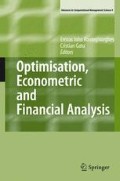Summary
The dependence structure of a family of self exciting threshold autoregressive moving average (SETARMA) models, is investigated. An alternative representation for this class of models is proposed and the exact autocorrelation function is derived in the case of two regimes. Some practical implications of the theoretical results are analysed and discussed via several examples of SETARMA structures of fixed orders
Access this chapter
Tax calculation will be finalised at checkout
Purchases are for personal use only
Preview
Unable to display preview. Download preview PDF.
References
Amendola A., Niglio M., Vitale C., (2006), The moments of SETARMA models, Statistics & Probability Letters, 76, 625–633.
Brännäs K., De Gooijer J.G., (2004), Asymmetries in conditional mean and variance: Modelling stock returns by asMA-asQGARCH, Journal of Forecasting, 23, 155–171.
Box G.E.P., Jenkins G.M., (1976), Time series analysis, forecasting and control, Holden-Day, San Francisco.
Brock W.A., De Lima P.J.F., (1996), Nonlinear time series complexity theory and finance, in Handbook of Statistics, 14, Elsevier.
Brockwell P.J., Liu J., Tweedie R., (1992), On the extence of stationary threshold autoregressive moving-average processes, Journal of Time Series Analysis, 13, 95–107.
Cont R., (2001), Empirical properties of asset returns: stylized facts and statistical issue, Quantitative Finance, 1, 223–236.
De Gooijer J., (1998), On threshold moving-average models, Journal of Time Series Analysis, 19, 1–18.
Engle R.F., (1982) Autoregrassive conditional heteroskedasticity with estimates of the variance for U.K. inflation, Econometrica, 50, 987–1008.
Fan J, Yao Q., (2003), Nonlinear time series: parametric and nonparametric methods, Springer, New York.
Franses P.H., Van Dijk D., (2000), Non-linear time series models in empirical finance, Cambridge University Press, Cambridge.
Granger C.W.J., Teräsvirta T., (1993), Modelling nonlinear relationships, Oxford University Press, Oxford.
Ling S., Tong H., (2005), Testing for a linear MA model against threshold MA models, The Annals of Statistics, 33, 2529–2552.
Liu J., Li W.K., Li C.W., (1997), On a threshold autoregression with conditional heteroskedasticity, Journal of Statistical Planning & Inference, 62, 279–300.
Liu J., Susko E., (1992), On strict stationary and ergodicity of a nonlinear ARMA model, Journal of Applied Probabilyty, 29, 363–373.
Nielsen H.A., Madsen H., (2001), A generalization of some classical time series tools, Computational Statistics & Data Analysis, 37, 13–31.
Pagan A., (1996), The econometrics of financial market, Journal of Empirical Finance, 3, 15–102.
Priestley M. B., (1988), Non-Linear and Non-Stationary Time Series Analysis, Academic Press, San Diego.
Tjøstheim D., (1994), Non-linear time series: a selective review, Scandinavian Journal of Statistics, 21, 97–130.
Tong H., (1983), Threshold models in nonlinear time series analysis, Springer-Verlag, New York.
Tong H., (1990), Non-linear time series: A dynamical system approach, Clarendon Press, Oxford.
Author information
Authors and Affiliations
Editor information
Editors and Affiliations
Rights and permissions
Copyright information
© 2007 Springer-Verlag Berlin Heidelberg
About this paper
Cite this paper
Amendola, A., Niglio, M., Vitale, C. (2007). The Autocorrelation Functions in SETARMA Models. In: Kontoghiorghes, E.J., Gatu, C. (eds) Optimisation, Econometric and Financial Analysis. Advances in Computational Management Science, vol 9. Springer, Berlin, Heidelberg. https://doi.org/10.1007/3-540-36626-1_7
Download citation
DOI: https://doi.org/10.1007/3-540-36626-1_7
Publisher Name: Springer, Berlin, Heidelberg
Print ISBN: 978-3-540-36625-6
Online ISBN: 978-3-540-36626-3
eBook Packages: Computer ScienceComputer Science (R0)

